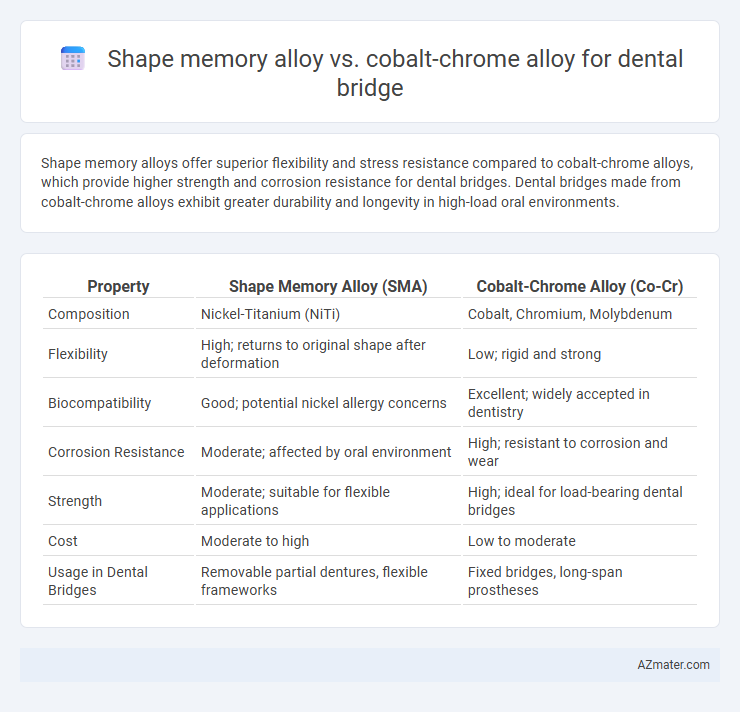Shape memory alloys offer superior flexibility and stress resistance compared to cobalt-chrome alloys, which provide higher strength and corrosion resistance for dental bridges. Dental bridges made from cobalt-chrome alloys exhibit greater durability and longevity in high-load oral environments.
Table of Comparison
| Property | Shape Memory Alloy (SMA) | Cobalt-Chrome Alloy (Co-Cr) |
|---|---|---|
| Composition | Nickel-Titanium (NiTi) | Cobalt, Chromium, Molybdenum |
| Flexibility | High; returns to original shape after deformation | Low; rigid and strong |
| Biocompatibility | Good; potential nickel allergy concerns | Excellent; widely accepted in dentistry |
| Corrosion Resistance | Moderate; affected by oral environment | High; resistant to corrosion and wear |
| Strength | Moderate; suitable for flexible applications | High; ideal for load-bearing dental bridges |
| Cost | Moderate to high | Low to moderate |
| Usage in Dental Bridges | Removable partial dentures, flexible frameworks | Fixed bridges, long-span prostheses |
Introduction to Dental Bridge Materials
Dental bridge materials, including Shape Memory Alloys (SMAs) and Cobalt-chrome alloys, play crucial roles in restorative dentistry by providing structural support and aesthetic function. Shape Memory Alloys offer unique flexibility and the ability to return to their original shape after deformation, useful in dynamic oral environments, while Cobalt-chrome alloys are renowned for their high strength, corrosion resistance, and durability in load-bearing dental bridges. The choice between SMAs and Cobalt-chrome alloys depends on specific clinical requirements such as biocompatibility, mechanical properties, and long-term performance in the oral cavity.
Overview of Shape Memory Alloys in Dentistry
Shape memory alloys (SMAs), primarily composed of nickel-titanium (NiTi), offer superior elasticity and biocompatibility for dental bridges, enabling adaptation to dynamic oral environments through their unique phase transformation properties. Compared to cobalt-chrome alloys, which provide high strength and corrosion resistance, SMAs enhance patient comfort due to their flexibility and stress-induced shape recovery, reducing the risk of framework fractures. The application of SMAs in dentistry supports minimally invasive procedures and long-term durability, making them ideal for bridges requiring repeated deformation without permanent deformation or loss of structural integrity.
Cobalt-Chrome Alloy: Properties and Applications
Cobalt-chrome alloy exhibits exceptional hardness, corrosion resistance, and biocompatibility, making it a preferred choice for dental bridges that require durability and long-term stability. Its high stiffness and wear resistance provide superior support under chewing forces, while its ability to be cast into precise, intricate shapes ensures excellent fit and comfort. Commonly applied in fixed partial dentures, cobalt-chrome alloys maintain structural integrity and resist deformation, outperforming shape memory alloys in dental prosthetic longevity and mechanical reliability.
Mechanical Strength Comparison
Cobalt-chrome alloy exhibits superior mechanical strength compared to shape memory alloys, making it more suitable for dental bridges under high occlusal forces. Shape memory alloys, such as NiTi, offer flexibility and elasticity but have lower yield strength and fatigue resistance than cobalt-chrome, limiting their load-bearing capacity. The higher modulus of elasticity and hardness of cobalt-chrome alloys contribute to enhanced durability and stability in long-term dental bridge applications.
Flexibility and Adaptability in Clinical Use
Shape memory alloys exhibit superior flexibility and adaptability in dental bridge applications due to their unique ability to return to a predetermined shape after deformation, enhancing patient comfort and reducing adjustment time. Cobalt-chrome alloys, while offering high strength and corrosion resistance, are significantly less flexible, making them less adaptable to dynamic oral conditions and potential anatomical variations. The flexibility of shape memory alloys allows for minimally invasive preparations and better accommodation to occlusal changes, whereas cobalt-chrome materials often require more precise fitting and may be prone to brittleness under repeated stress.
Biocompatibility and Patient Outcomes
Shape memory alloys, such as nickel-titanium, exhibit excellent biocompatibility due to their corrosion resistance and reduced ion release, which minimizes allergic reactions and promotes better tissue integration in dental bridges. Cobalt-chrome alloys also demonstrate high biocompatibility with durable mechanical properties but may pose a higher risk of metal ion release and hypersensitivity in some patients. Patient outcomes favor shape memory alloys for flexibility and comfort, while cobalt-chrome alloys are preferred for their strength and longevity in high-stress oral environments.
Longevity and Corrosion Resistance
Shape memory alloys (SMAs) exhibit superior corrosion resistance due to their ability to form stable oxide layers, which enhances their longevity in the oral environment compared to cobalt-chrome alloys. Cobalt-chrome alloys, while highly durable and resistant to wear, are more prone to corrosion over time due to galvanic reactions and oral pH fluctuations. The extended lifespan of SMAs in dental bridge applications is attributed to their unique phase transformation properties, which also contribute to maintaining structural integrity and biocompatibility under dynamic oral conditions.
Esthetics and Color Compatibility
Shape memory alloys used in dental bridges provide excellent flexibility but often exhibit a metallic gray color that can compromise esthetics, especially in anterior restorations. Cobalt-chrome alloys offer superior color compatibility with dental ceramics due to their natural silver-white appearance, enhancing the overall esthetic outcome of the bridge. The improved color match of cobalt-chrome alloys makes them preferable for visible areas where esthetic demands are high.
Cost Analysis and Accessibility
Shape memory alloys (SMAs) generally offer a cost-effective solution for dental bridge frameworks due to lower material and manufacturing expenses compared to cobalt-chrome (Co-Cr) alloys, which involve more complex casting and finishing processes. While Co-Cr alloys provide superior strength and durability, their higher price point and specialized equipment requirement limit accessibility, especially in low-resource dental clinics. SMAs, with their flexibility and ease of adjustment, present a more accessible option for patients seeking affordable dental restorations without compromising basic functional performance.
Clinical Recommendations and Conclusion
Shape memory alloys offer superior flexibility and resilience for dental bridges, promoting better adaptation to dynamic oral conditions and reducing mechanical failures. Cobalt-chrome alloys provide exceptional strength and corrosion resistance, making them preferable for long-span bridges requiring high load-bearing capacity. Clinically, shape memory alloys suit patients needing improved comfort and adaptability, while cobalt-chrome alloys are recommended for durability and structural integrity in permanent restorations.

Infographic: Shape memory alloy vs Cobalt-chrome alloy for Dental bridge
 azmater.com
azmater.com